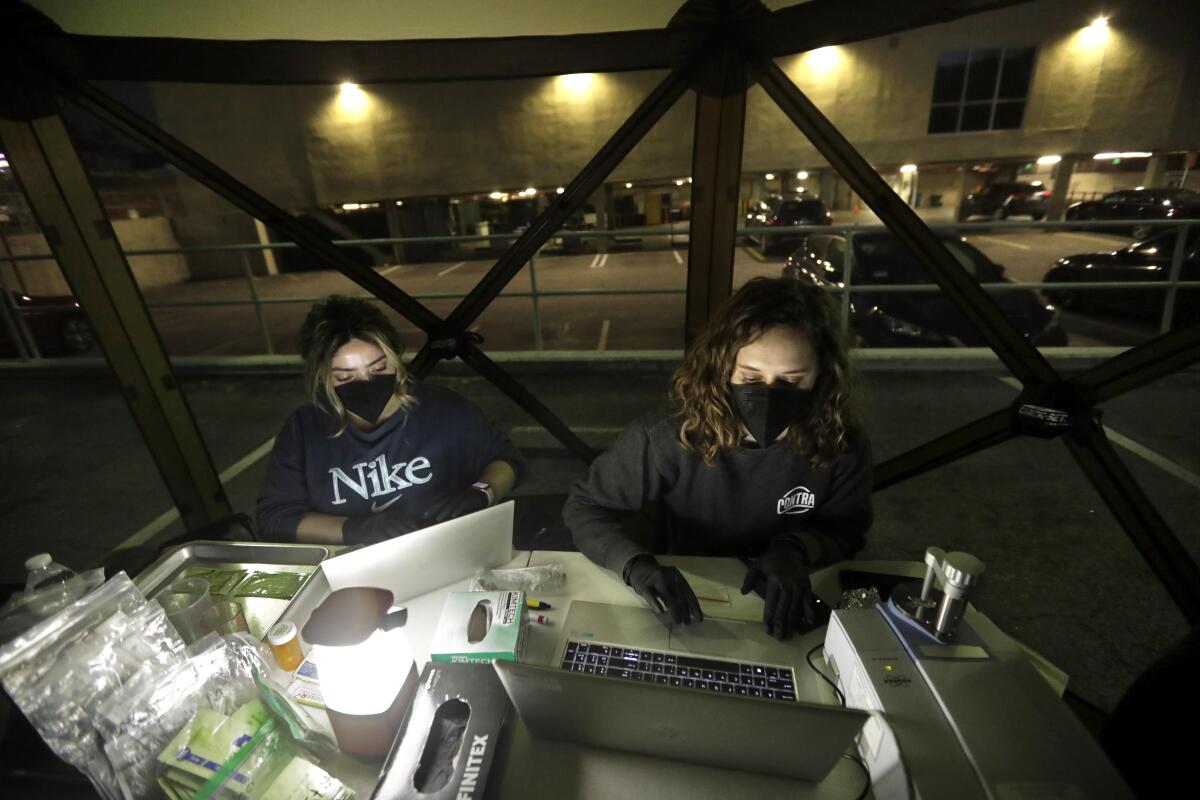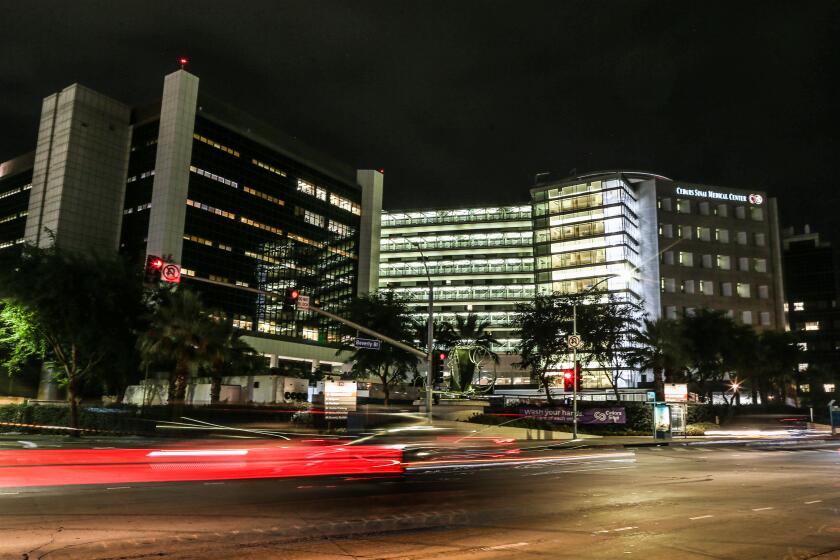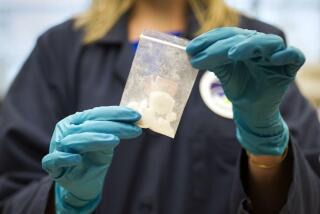An industrial chemical is showing up in fentanyl in the U.S., troubling scientists

An industrial chemical used in plastic products has been cropping up in illegal drugs from California to Maine, a sudden and puzzling shift in the drug supply that has alarmed health researchers.
Its name is bis(2,2,6,6-tetramethyl-4-piperidyl) sebacate, commonly abbreviated as BTMPS. The chemical is used in plastic for protection against ultraviolet rays, as well as for other commercial uses.
In an analysis released Monday, researchers from UCLA, the National Institute of Standards and Technology (NIST) and other academic institutions and harm reduction groups collected and tested more than 170 samples of drugs that had been sold as fentanyl in Los Angeles and Philadelphia this summer. They found roughly a quarter of the drugs contained BTMPS.
An obstetrician-gynecologist has been barred from practicing at Cedars-Sinai following an investigation into complaints. The doctor has denied wrongdoing.
Researchers called it the most sudden change in the U.S. illegal drug supply in recent history, based on chemical prevalence. They found that BTMPS sometimes dramatically exceeded the amount of fentanyl in drug samples and, in some cases, had made up more than a third of the drug sample.
It was also a growing presence in fentanyl over the summer: In June, none of the L.A. fentanyl samples tested by the team contained BTMPS, the analysis found. By August, it was detected in 41% of them.
“This is effectively unprecedented,” said Morgan Godvin, one of the authors of the study and project director for Drug Checking Los Angeles, a UCLA project that works in partnership with the L.A. County Department of Public Health to analyze illicit drugs.
“We have no idea just how many people have been exposed,” Godvin said, but if the high prevalence among drug samples tested so far is any indication, “that translates to tens of thousands of fentanyl users being exposed to BTEMPS, sometimes at very high volume.”
The findings were publicly released as a preprint — research that has not been peer reviewed — on the website of Drug Checking Los Angeles and on medRxiv, a website where scientists share preliminary findings.
BTMPS has been studied in rats for its potential to reduce withdrawal symptoms from morphine and affect nicotine use, but it can be toxic and even deadly to rodents at sufficient doses, and health researchers say there is an urgent need for more studies on its effects on the human body.
The PubChem database lists a number of possible hazards associated with BTMPS, including skin irritation and eye damage. Godvin was alarmed by animal studies indicating dangers from inhaling BTMPS — such as tremors and shortness of breath — because smoking is now common in L.A. among people who use fentanyl.
People who use drugs have said that BTMPS can smell like bug spray or plastic and have reported blurred vision, nausea and coughing after ingesting it. One told researchers that “it smelled so bad I could barely smoke it.” The UCLA and NIST researchers warned that “with such a sudden and sustained prevalence in the drug supply, users are at risk of repeated, ongoing exposures, which may compound health effects.”
A 35-year-old man in Los Angeles said that in recent months, he had noticed a rubbery or synthetic taste in the fentanyl he used. “I was asking my friend that I buy from, ‘What the hell is this?’” said the man, who requested anonymity to speak about his drug use.
When he took samples that were supposed to be fentanyl to Drug Checking Los Angeles to analyze, he learned that some contained the strange chemical. The 35-year-old said he now tries to avoid BTMPS, but “a lot of people are just trying to get anything to keep from being sick” from opioid withdrawal.
Whatever clandestine labs are doing, he said, “we’re the guinea pigs.”
An autistic child. The struggle for services. The 911 calls. This is the harrowing story of how one mom scrambled to get help for her son and keep her head above water.
L.A. and Philadelphia are far from the only places where the chemical has popped up: The team also detected BTMPS in trace amounts of drugs left behind on drug paraphernalia from other locations, including Delaware, Maryland and Nevada.
As of last week, a University of North Carolina program that tests drug samples from across the country had also found BTMPS in more than 200 samples from a dozen states stretching from the West Coast to Maine. UNC senior scientist Nabarun Dasgupta said the chemical began showing up in drug samples that it tested this summer, most often mingled with fentanyl, both in powder form and in fake pills.
Alex Krotulski, a director at the nonprofit Center for Forensic Science Research and Education in Pennsylvania, said the amount of BTMPS found in drug samples it has tested varies dramatically — sometimes making up a small amount, sometimes amounting to the “primary component” in the sample.
Unlike other adulterants added to fentanyl for their psychoactive effects, “it’s not like it’s something that you go out and you use a bunch of to get high,” Krotulski said. The UCLA and NIST team found that people who use drugs rated samples high in BTMPS as “bunk” — low in quality — and broadly saw it as “highly undesirable.”
Yet another oddity is that BTMPS has not followed a familiar path for new drugs in the U.S. Instead of showing up in one area and spreading to others, “this one has hit all at once across the U.S. within a two-week period,” said Tara Stamos-Buesig, founder and chief executive of the Harm Reduction Coalition of San Diego.
Stamos-Buesig, whose group helps analyze the contents of illegal drugs in San Diego to inform and protect people, said that “I’ve told people for a while — we can’t hyper-focus on fentanyl” as if it were the only threat.
“There’s a lot of other stuff coming on board,” Stamos-Buesig said.
L.A. County jurors decided largely in favor of a man with silicosis who had to undergo a double lung transplant after years of cutting engineered stone countertops.
The UCLA and NIST analysis suggested one possible scenario: Illegal drug manufacturers might be adding BTMPS to fentanyl precursors or to the final product “at a high level in the supply chain,” possibly to stabilize them from degrading from light or heat exposure as illicit drugs are made, stored and transported, they wrote.
UCLA assistant professor Chelsea Shover added that the team had found BTMPS for sale on online platforms like Amazon and Alibaba with similar wording to what Chinese chemical companies had used in the past to market to fentanyl producers, with sellers touting their “experience getting through Mexican customs.”
“This is clearly implying that this is to be used to make illicit drugs,” Shover said. “It’s stuff you wouldn’t expect to see if it was just selling an industrial chemical in a standard way.”
As it stands, there is no test strip that can quickly detect BTMPS as there is for fentanyl. Nor is the chemical routinely tested for by doctors or medical examiners, which means that if someone has been harmed by BTMPS they took accidentally, “clinicians would have no way of knowing,” the UCLA and NIST team wrote.
The UNC Street Drug Analysis Lab likewise said that much remains unknown at this point, including whether BTMPS poses an overdose risk, although the lab cautions that “EVERY substance at some volume will be toxic.”
Dasgupta said the detection of BTMPS represents the first example of the burgeoning network of drug checking programs working together to find a substance “before any health authorities or any law enforcement did.” Godvin said that “just a few years ago, we wouldn’t have even known about this” and urged Angelenos to get drugs analyzed through Drug Checking Los Angeles if they are able.
In a drug supply already riddled with threats like fentanyl and the animal tranquilizer xylazine, “this gives us a whole other thing to worry about,” Godvin said.
More to Read
Sign up for Essential California
The most important California stories and recommendations in your inbox every morning.
You may occasionally receive promotional content from the Los Angeles Times.














